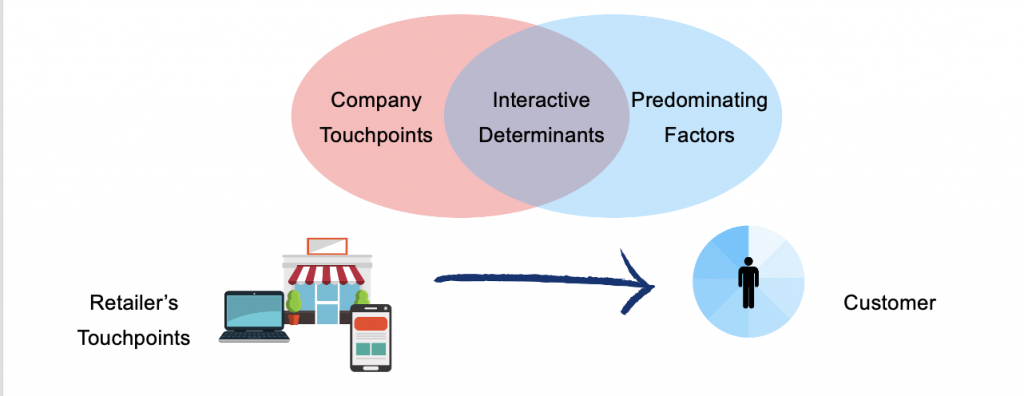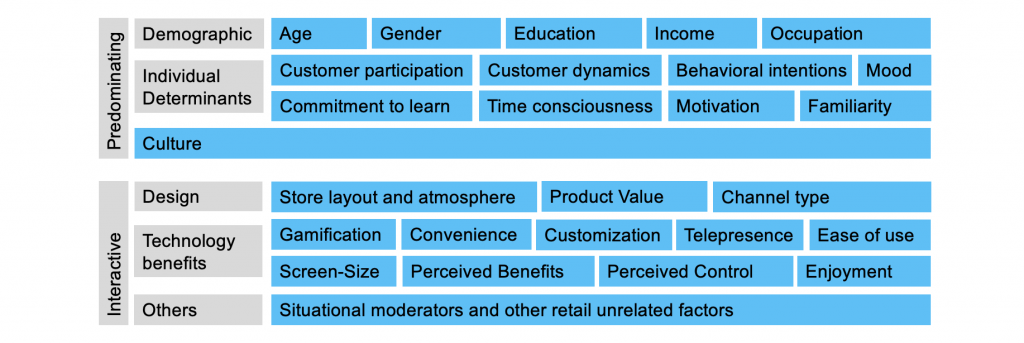In the digital age, retailers compete through various sales channels, both online and offline, with the effect that improving customer experience (CX) has increasingly gained attention in this omnichannel era. Hence, researchers repeatedly found that improved CX can result in increased customers’ satisfaction, purchase intentions, loyalty, trust, word-of-mouth intentions, and the willingness to engage with the brand, just to name a few possible marketing goals (e.g., Bleier et al., 2019; Krasonikolakis et al., 2018; Martin et al., 2015; Micu et al., 2019; Roy et al., 2020; Srivastava & Kaul, 2016; Terblanche, 2018).

1. CX and the Role of Emotions.
Hence, researchers, as well as marketing experts advise to improve CX. On a personal level, we all know if we have witnessed a good or a bad experience with a company. Yet, from the retailer’s level, CX is a very broad term. It is surprising just how many of the company’s contact points are considered under this umbrella. Among others, the retailers’ store atmosphere, as well as product, social, and even price experiences, can be considered a part of CX (see a full list of factors in our recent literature review). Knowing that CX is such a multidimensional and broad construct comes with various issues.
Most importantly: on which CX factors should retailers lay their focus on when trying to improve CX? Well, let’s take a step back and think about a personal experience, might it be at a shopping center or during the last vacation. There is one thing that stays long after the particular event happened: the way how it made us feel. This is also what researchers who studied CX found: especially the affective CX is crucial for customers (e.g., Martin et al., 2015).
2. How Retailers Can Improve Their Affective CX.
Knowing about the important role of a customer’s emotions brings retailers to the next step: constructing how you want your customer to feel. As a retailer, you might ask yourself: which emotions do I want my customer to ‘attach’ with my brand? Which emotions do I want my customer to experience when she/he shops at my store? Hence, we reviewed studies on retail CX and found a wide range of emotions that might explain some of the roots of CX (see our recently published literature review for a full list). Especially a customer’s level of positive emotions like enjoyment, entertainment, excitement, and peacefulness before, during, and after the shopping encounter was found to improve CX (Hermes & Riedl, 2020b).

However, customers also have a certain set of expectations of how the interaction with a company should look. Let’s say the retailer promises to ‘go the extra mile’ in provided services. Hence, the customer expects excellent service when visiting the shop or calling customer service, yet she/he does not receive that promised service. These unmet expectations can lead the customer to feel confused or annoyed, resulting in a negative CX. Hence, next to developing strategies that cause positive emotional experiences, it is essential for retailers to learn about the customer’s needs and expectations. Meeting these expectations can help to avoid negative CX. To summarize, the retailers’ efforts to “engineer customer emotions” is an important puzzle piece when planning to improve CX.
3. CX Determinants: Interactive vs. Predominating Factors.
Considering customers’ emotions is crucial when improving CX. However, emotions and experiences – in general – are something very personal. CX is always an interaction between a company and its customers, and with every company-customer interaction, a customer’s psychology is also at play. It follows that people are different and so is their perceived CX. For retailers, this is important to know, because it highlights that the retailer can plan and create CX only up to a certain point – how the customer perceives the company-customer interaction, however, is out of their reach.
It follows that the company can influence some CX determinants (e.g., a retailer can try to create an enjoyable online shopping experience), yet other determinants are out of their reach (e.g., the customer’s age, gender, mood, or commitment to learn). Accordingly, we sort CX determinants into two categories: (i) the predominating factors which cannot be influenced and (ii) the interactive determinants which can at least partially be influenced by the retailer. The following figure visualizes the relationship between these types of determinants.

The preceding graphic shows that companies provide certain touchpoints for their customers (e.g., the own online shop). The retailer can actively design and plan their own touchpoints (e.g., the online shop layout = interactive determinant), yet how the customer perceives their store and its layout also strongly depends on the customer individual factors (e.g., a customer’s age or gender = predominating factor). The following graphic gives an overview of possible predominating factors such as a customer’s demographics or other individual determinates like a customer’s mood or commitment to learn. These factors can hardly – if at all – be influenced by the retailer. Next, interactive determinants include various design factors (e.g., web or in-store design), technology benefits (e.g., website customization or ease of use). Hence, for retailers, it is crucial to develop their own touchpoints by improving interactive determinants while still keeping the predominant factors of their customers in mind.

4. Emotions and CX During the COVID-19 Pandemic: Final Thoughts.
The current COVID-19 pandemic has affected the customer in several ways. For once, digital retailing has gotten an even steeper upwards trend. Customers are shopping more online or combining online and offline channels (e.g., click and collect). Hence, more than ever, retailers need to seamlessly integrate various channels to provide an omnichannel-experience. This, of course, highlights that if retailers want to improve their affective CX, they need to consider all shopping channels. Hence, it is not enough for retailers to think about how the store atmosphere can support an enjoyable CX; even more, strategies must be in place for various channels and touchpoints.
Further, the current pandemic also brings emotional challenges for customers and retailing staff. A recent study by Szymkowiak et al. (2020), for example, found that in-store customers perceive a higher risk of getting infected, which decreased the perceived pleasure during shopping. Hence, retailers need to find the fine balance between providing an efficient shopping experience to decrease the risk of infection (by decreasing the customer’s time inside the store) but, on the other side, trying to still provide an emotionally rewarding experience.
Acknowledgements: This research was supported by the European Union Horizon 2020 research and innovation programme under the Marie Sklodowska-Curie grant agreement No. 765395.
References
Bleier, A., Harmeling, C. M., & Palmatier, R. W. (2019). Creating Effective Online Customer Experiences. Journal of Marketing, 83(2), 98–119. https://doi.org/10.1177/0022242918809930
Hermes, A., & Riedl, R. (2020a). The Nature of Customer Experience and its Determinants in the Retail Context: Literature Review. In WI2020 Zentrale Tracks (pp. 1738–1749). GITO Verlag. https://doi.org/10.30844/wi_2020_r5-hermes
Hermes, A., & Riedl, R. (2020b). How to Measure Customers’ Emotional Experience? A Short Review of Current Methods and a Call for Neurophysiological Approaches. In F. Davis, R. Riedl, J. vom Brocke, P.-M. Léger, A. Randolph, & T. Fischer (Eds.), Lecture Notes in Information Systems and Organisation – Information Systems and Neuroscience. NeuroIS Retreat 2020 (Vol. 43, pp. 211–219). Springer. https://doi.org/10.1007/978-3-030-60073-0_25
Krasonikolakis, I., Vrechopoulos, A., Pouloudi, A., & Dimitriadis, S. (2018). Store layout effects on consumer behavior in 3D online stores. European Journal of Marketing, 52(5/6), 1223–1256. https://doi.org/10.1108/EJM-03-2015-0183
Martin, J., Mortimer, G., & Andrews, L. (2015). Re-examining online customer experience to include purchase frequency and perceived risk. Journal of Retailing and Consumer Services, 25, 81–95. https://doi.org/10.1016/j.jretconser.2015.03.008
Micu, A. E., Bouzaabia, O., Bouzaabia, R., Micu, A., & Capatina, A. (2019). Online customer experience in e-retailing: implications for web entrepreneurship. International Entrepreneurship and Management Journal, 15, 651–675. https://doi.org/10.1007/s11365-019-00564-x
Roy, S. K., Gruner, R. L., & Guo, J. (2020). Exploring customer experience, commitment, and engagement behaviours. Journal of Strategic Marketing, 1–24. https://doi.org/10.1080/0965254X.2019.1642937
Srivastava, M., & Kaul, D. (2016). Exploring the link between customer experience-loyalty-consumer spend. Journal of Retailing and Consumer Services, 31, 277–286. https://doi.org/10.1016/j.jretconser.2016.04.009
Szymkowiak, A., Gaczek, P., Jeganathan, K., & Kulawik, P. (2020). The impact of emotions on shopping behavior during epidemic. What a business can do to protect customers. Journal of Consumer Behaviour, June, 1–13. https://doi.org/10.1002/cb.1853
Terblanche, N. S. (2018). Revisiting the supermarket in-store customer shopping experience. Journal of Retailing and Consumer Services, 40, 48–59. https://doi.org/10.1016/j.jretconser.2017.09.004